The CBA China Annual Conference 2025 successfully concluded in Suzhou on June 28, gathering over 30,000 professionals across 120+ forums to explore technological advancements and global collaboration.
Dr. Hanjun Zou, TFM of Medicilon Chuansha, presented “Peptide Therapeutics: Preclinical Strategy,” detailing non-clinical research strategies for peptide drugs to accelerate their development and to improve treatment options.
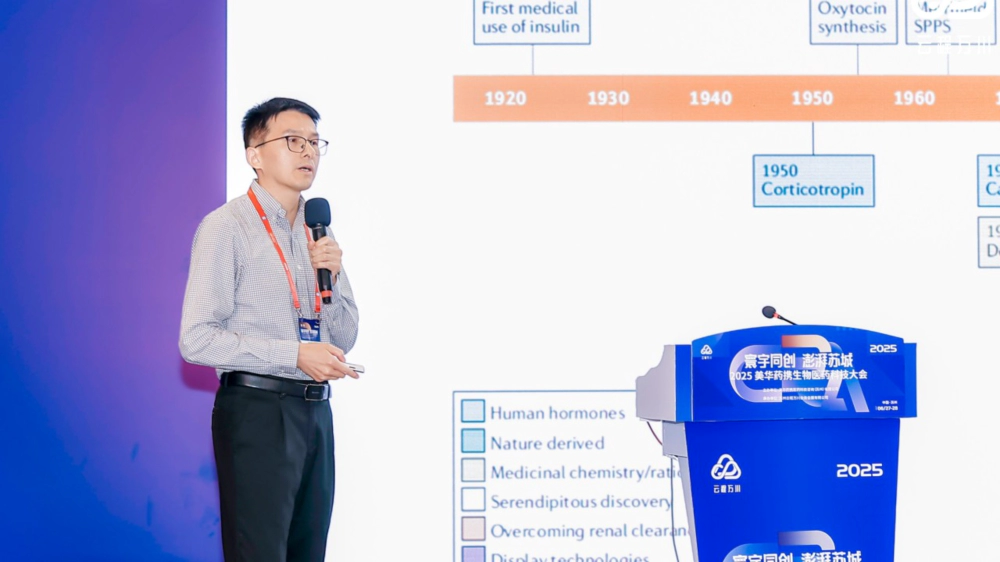
Peptides are gaining remarkable popularity in clinical diagnosis and treatment due to their high selectivity and minimal side effects.
Historical Evolution of Peptide Therapeutics
Historical timeline of key milestones, developments and drug approvals in the peptide therapeutics field is listed below.
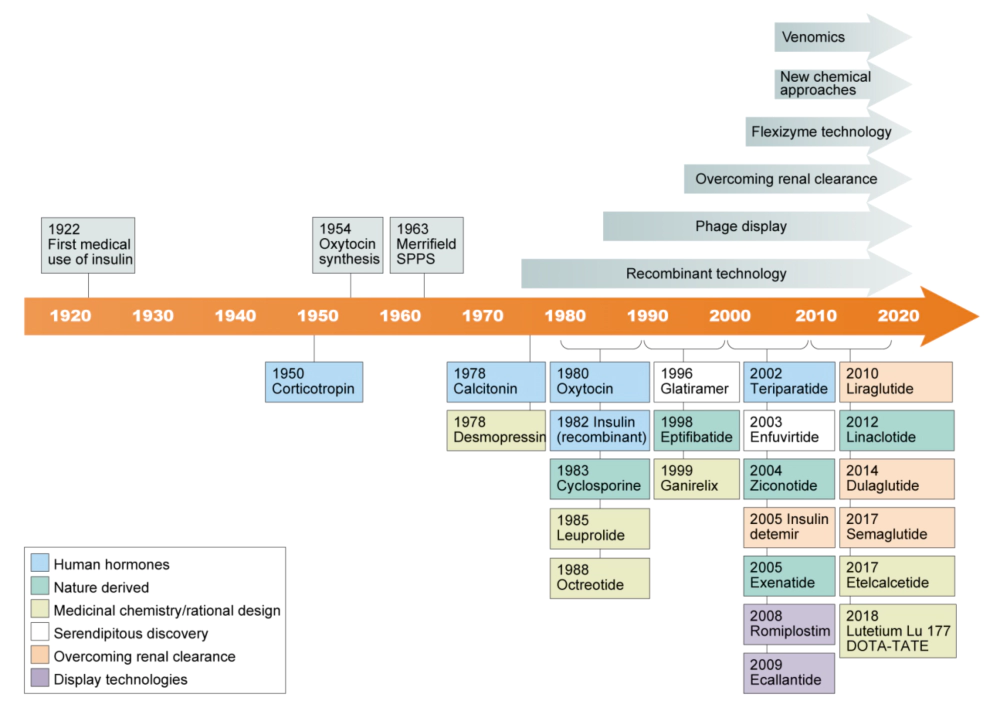
Trends in peptide drug discovery[1]
Peptide Therapeutics: Overview
Peptide therapeutics maintain a stable presence in the pharmaceutical landscape. The table below present number of novel FDA-approved therapeutics as a total, peptides drugs and percentage of peptides from total for years 2016-2024 (https://www.fda.gov/).
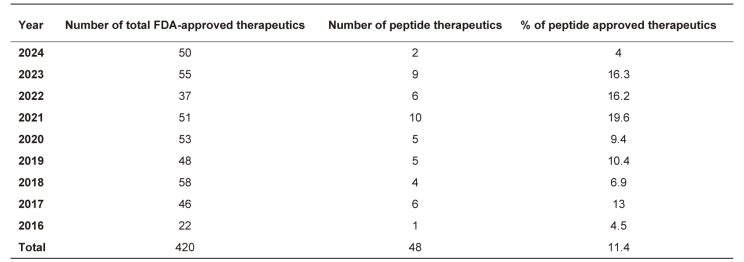
FDA Approval Trends[2]
Peptide Drug: A Comparison
Peptides bridge small molecules and biologics with distinct pharmacological benefits. Peptides usually have a favorable safety profile with low off-target effects. Furthermore, peptides are degraded to non-toxic metabolites (amino acids) or are filtered out by the kidney without significant CYP metabolism, reducing the risk for drug-drug interactions. Their overall hydrophilicity usually prevents tissue accumulation, and peptides show a lower immunogenicity compared to biologics (especially therapeutic proteins).
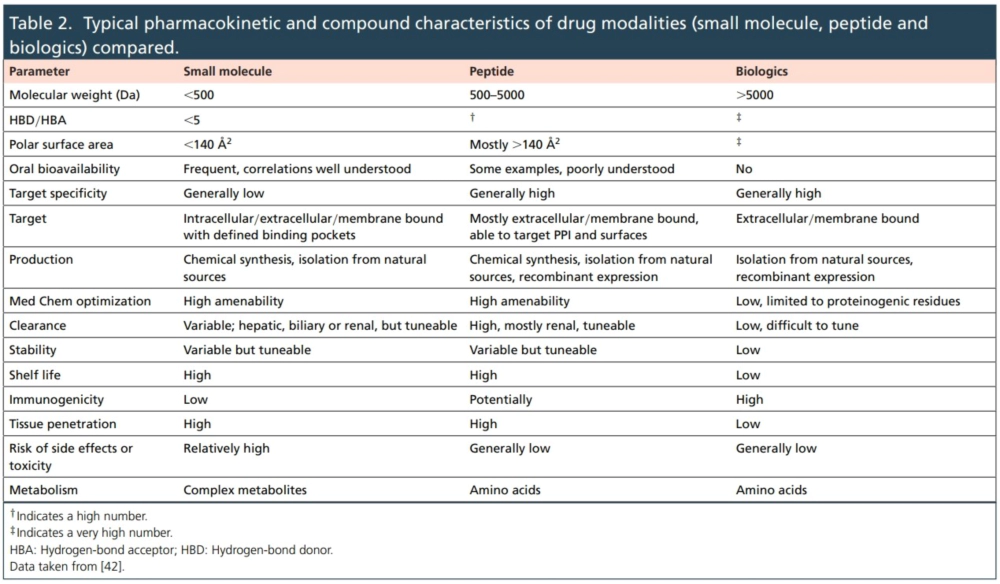
Typical pharmacokinetic and compound characteristics of drug modalities[3]
ADME Properties of Peptide Therapeutics
Absorption
Several routes of delivery are available for therapeutic peptides. The absorption of peptide drugs is significantly dependent on the administration route.
- Injections (IV, SC, or IM) bypass first-pass metabolism. IV administration avoids gastrointestinal enzymes, while SC/IM injections utilize capillaries and lymphatic vessels for systemic absorption. However, proteases and peptidases at injection sites can degrade peptides.
- Oral administration presents challenges due to poor metabolic stability and permeability, resulting in low bioavailability.
- Nasal and inhalation routes offer rapid absorption, fast onset, hepatic first-pass avoidance, high bioavailability, and direct delivery to respiratory targets.
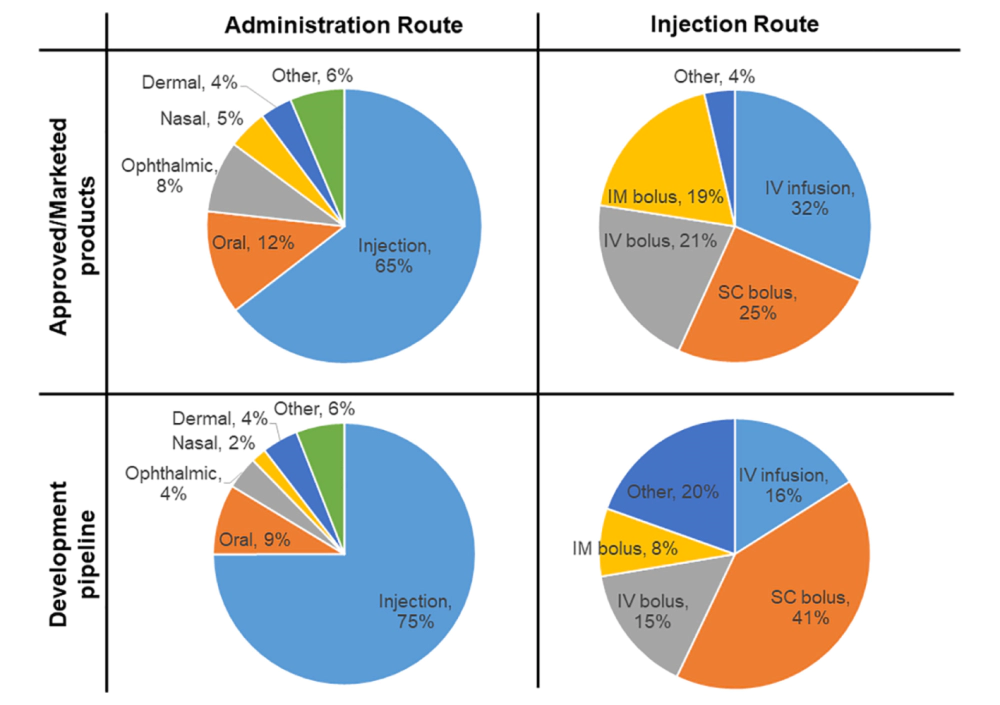
Breakdown of peptide products by administration and injection routes[4]
Distribution
- Peptide drugs have weak lipophilicity, low permeability, and difficulty directly crossing cell membranes to enter cells, so peptides mainly enter cells through receptor-mediated endocytosis and phagocytosis.
- The volume of distribution (Vd) of peptide drugs is usually low, and they are mainly distributed with blood circulation to tissues such as the heart, liver, lung, spleen, pancreas, and kidneys.
Metabolism and Excretion
- Peptide are mainly degraded by proteases or peptidases, and most of the produced amino acids and small peptides enter the endogenous amino acid pool for the synthesis of endogenous substances.
- Proteases are widely distributed in the gastrointestinal tract and tissue organs of the body and can be divided into endopeptidases and exopeptidases.
- Proteases often have a certain specificity for peptide hydrolysis, i.e., selectively acting on certain specific amino acid sites. The hydrolysis of peptides and proteins usually begins with endopeptidases, and the short peptides produced by enzymatic hydrolysis can be further hydrolyzed by exopeptidases.
- Peptides also undergo elimination via endocytic elimination, target-mediated elimination, and glomerular filtration, with enzymatic degradation and glomerular filtration generally considered the main pathways.
- Standalone metabolite safety assessment studies were not conducted for peptide as the major human metabolites were deemed not to be unique.
Preclinical Safety Assessment Strategy
Species Selection
- Select pharmacologically active species relevant to humans;
- Generally, use two relevant species. A single specie may suffice if only one relevant specie is identifiable;
- While short-term studies may require two species, long-term toxicity studies may be justifiable with only one specie.

A. General rodent toxicology species used in peptide drug development; B. General non-rodent toxicology species used in peptide drug development.[5]
General Toxicology
- Generally, multi-organ toxicity without a clear pharmacological basis for the observed effects is rare among the synthetic and recombinant peptides, which may be a result of high specificity for the target, limited cellular permeability, or the large number of hormone analogs in this class.
- Off-target toxicities have been consistently observed for the non-ribosomal peptides (eg. Anidulafungin, etc). These generally included clinical signs related to histamine release and liver and/or kidney toxicity. The toxicity profile of these non-ribosomal peptides may be related to higher permeability, modest selectivity, or high doses typically used for antimicrobial therapies.
- For SC/IM administered peptide drugs, injection site reactions are common findings. These reactions include itching, swelling, redness, pain, tenderness, and histopathologic findings of necrosis which are translable to the clinic in many cases (eg. Ganirelix and Enfuviratide).
The duration of chronic toxicology studies followed ICH S4 guidance. Seventy-four percent of the rodent studies were ≥ 6-month in duration, and the same percent of the non-rodent studies were ≥ 9-month in duration. C. Longest duration of rodent toxicology studies conducted for peptide therapeutics; D. Longest duration of non-rodent toxicology studies conducted for peptide therapeutics.

C. Longest duration of rodent toxicology studies conducted for peptide therapeutics; D. Longest duration of non-rodent toxicology studies conducted for peptide therapeutics.[5]
Developmental & Reproductive Toxicology (DART)
- As many of the peptide therapeutics act as analogs or antagonists for hormones, which in many cases are required for reproductive health and fetal development, the DART studies are considered important for this modality.
- There were no examples of primary DART studies performed in NHPs, as is commonly seen for biologic products.

Development and reproductive toxicology studies. A. Rodent fertility studies (Seg I); B. Embryo-fetal development studies (Seg II); and C. Pre-and postnatal development studies (Seg III).[5]
Genotoxicity
- Genotox testing was conducted for the majority of approved peptides with mostly negative results.
- Possible false positive in Ames assay due to release of histidine from peptide (e.g., Glucagon).
- Etelcalcetide, tested positive in the Ames assay, is synthesized chemically and does not contain histidine or tryptophan as part of its structure. Further in vitro and in vivo genotoxicity studies showed negative results. Based on the overall weight-of-evidence, etelcalcetide was considered not to be genotoxic.
Carcinogenicity
- Carcinogenicity assessments were not conducted because they were deemed unnecessary due to short clinical dosing, anti-cancer indication, immunogenicity development, or the sponsor accepting a positive carcinogenicity label claim based on class effect.
- For the human parathyroid hormone and its analogs (Abalopartide and Teripartide) exaggerated pharmacology-mediated tumors of the bone have been reported in rats.
- Insulin is known to have mitotic effects, consequently insulin Glulisine and Insulin glargine were carcinogenic in rodents.
- Degarelix, a gonadotropin releasing hormone antagonist indicated for the treatment of advanced prostate cancer, reported hemangiomas and hemangiosarcomas in female rats, but was not carcinogenic in male rats or mice, and was nongenotoxic in vitro.
- Importantly, all the peptides that tested positive for carcinogenicity were negative for genotoxicity, suggesting the carcinogenic effects were due to pharmacology.
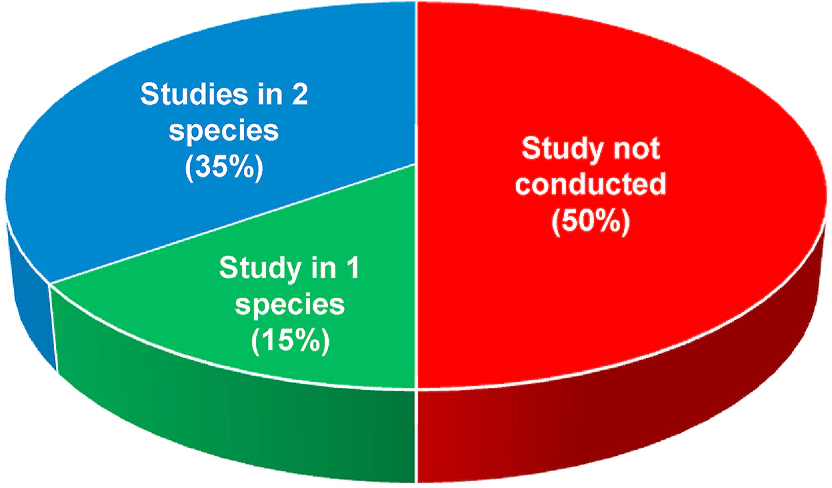
Safety Pharmacology
- hERG test was submitted in roughly half of approved peptides, including peptides with BLA.
- Most approved peptides included standalone studies in rats and/or dogs to assess cardiovascular and respiratory effects, sometimes supplemented or replaced by studies in non-human primates.

Cardiovascular safety pharmacology studies conducted during peptide development.[5]
Bioanalysis of Peptide Drug: Key Consideration
Challenge from structure
- Similarity to natural peptide
- Immunogenicity
- Structural difference/similarity between species
- Easy adsorption
Challenge from administration and dose
- Typically subcutaneous
- Low dose
- Linear range and sensitivity
Stability
- Subject to degradation
- Freeze/thaw/vibration/configuration/acid/base stability
- Half life can be short (sensitivity/LLOQ)
Strategy
- Assess sampling condition and storage condition in advance based on the structure and composition
- Select appropriate anticoagulant
- Add appropriate enzyme inhibitor
- Low adsorption tube
- Prevention of hemolysis
- Regular check of pH of reagent or freshly prepared
Immunogenicity Assessment
Antibody responses (e.g., titer, number of responding animals, neutralizing or non-neutralizing activity) should be characterized and correlated with pharmacological and/or toxicological changes. Antibody induction in animals is not always predictive of antibody formation in humans. Antibody detection alone should not be the sole criterion for early termination or modification of a preclinical safety study.

Immunogenicity assessment in nonclinical and clinical studies[5]
Immunogenicity assessment in nonclinical and clinical studies (total with data: 46 peptides). A. Immunogenicity assessment conducted in nonclinical and clinical studies; B. Incidence of ADA in nonclinical studies; and C. Incidence of ADA in clinical studies.
Challenge on positive antibody
- Moderate molecular weight, limited epitope
- Not easy to generate antibody by using routine immune strategy
- Low titer
Strategy
- Immune by using peptide conjugation
- Try different adjuvant
- Homologous tandem recombinant expression of peptide antigen
- Select animal species with relatively high genetic divergence for immunization
Conclusion
Peptide therapeutics combine precision targeting, low systemic toxicity, and evolving engineering solutions to address unmet medical needs. The preclinical framework emphasizes species relevance, mechanistic toxicology, and adaptive testing strategies. With advancements in delivery and design, peptides are poised to expand into new disease areas, reinforced by their growing share of the FDA approval landscape.
Reference:
- [1] Markus Muttenthaler, et al. Trends in peptide drug discovery. Nat Rev Drug Discov. 2021 Apr;20(4):309-325. doi: 10.1038/s41573-020-00135-8.
- [2] Koulla Achilleos, et al. Beyond Efficacy: Ensuring Safety in Peptide Therapeutics through Immunogenicity Assessment. J Pept Sci. 2025 Jun;31(6):e70016. doi: 10.1002/psc.70016.
- [3] Christina Lamers. Overcoming the Shortcomings of Peptide-Based Therapeutics. Future Drug Discovery, 2022, 4:2.
- [4] Ahil N. Ganesh, et al. Patient-centric design for peptide delivery: Trends in routes of administration and advancement in drug delivery technologies. Medicine in Drug Discovery. 2021 Mar; 9:100079.
- [5] Mayur S Mitra, et al. Development of peptide therapeutics: A nonclinical safety assessment perspective. Regul Toxicol Pharmacol. 2020 Nov:117:104766. doi: 10.1016/j.yrtph.2020.104766.
